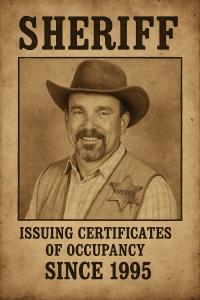jar546
CBO
They say there was a time, not too long ago, when the frontier towns of Connecticut were wild and lawless. Builders rode roughshod across the land, throwing up structures without permits, ignoring setbacks, skipping inspections, and laughing in the face of the code book. It was a dangerous time. Safety was a suggestion, not a standard, and good workmanship was harder to find than water in the desert.
But then came the Sheriff.
Nobody really knows where he came from. Some say he was born with a rolled set of blueprints in one hand and a red tag in the other. Others swear he once stopped a framing crew dead in their tracks just by reading aloud from Chapter 6 of the International Residential Code. All they know for sure is, when the Sheriff arrived, everything changed.
With a worn-out badge shaped like a Certificate of Occupancy, he rode from town to town, taming job sites and bringing order to the chaos. He enforced slab inspections like a man possessed, stopped unlicensed tradesmen before they could even plug in their circular saws, and made plan reviewers believe in miracles again. Rumor has it he once caught a contractor trying to pour footers without rebar, and with nothing but a hard stare and a copy of the zoning ordinance, convinced him to start over without a single word.
Folks still talk about the Sheriff’s code enforcement skills to this day. Not because he shouted. Not because he bullied. But because he had something you cannot fake — respect for the code, respect for the craft, and a quiet understanding that doing it right matters more than doing it fast.
In the towns where he rode, it is said that you could tell a man’s worth not by the size of his pickup truck, but by how well his permit packet was organized. Life was better under the Sheriff. Slabs were square, setbacks were honest, and framing inspections did not feel like a game of roulette.
Some say the Sheriff is still out there today, badge a little heavier with experience, boots a little more worn from walking rooftops and crawlspaces, but eyes still sharp enough to spot a missing hold-down from fifty yards away.
If you see him, tip your hat.
And for heaven's sake, make sure your paperwork is in order.
But then came the Sheriff.
Nobody really knows where he came from. Some say he was born with a rolled set of blueprints in one hand and a red tag in the other. Others swear he once stopped a framing crew dead in their tracks just by reading aloud from Chapter 6 of the International Residential Code. All they know for sure is, when the Sheriff arrived, everything changed.
With a worn-out badge shaped like a Certificate of Occupancy, he rode from town to town, taming job sites and bringing order to the chaos. He enforced slab inspections like a man possessed, stopped unlicensed tradesmen before they could even plug in their circular saws, and made plan reviewers believe in miracles again. Rumor has it he once caught a contractor trying to pour footers without rebar, and with nothing but a hard stare and a copy of the zoning ordinance, convinced him to start over without a single word.
Folks still talk about the Sheriff’s code enforcement skills to this day. Not because he shouted. Not because he bullied. But because he had something you cannot fake — respect for the code, respect for the craft, and a quiet understanding that doing it right matters more than doing it fast.
In the towns where he rode, it is said that you could tell a man’s worth not by the size of his pickup truck, but by how well his permit packet was organized. Life was better under the Sheriff. Slabs were square, setbacks were honest, and framing inspections did not feel like a game of roulette.
Some say the Sheriff is still out there today, badge a little heavier with experience, boots a little more worn from walking rooftops and crawlspaces, but eyes still sharp enough to spot a missing hold-down from fifty yards away.
If you see him, tip your hat.
And for heaven's sake, make sure your paperwork is in order.

